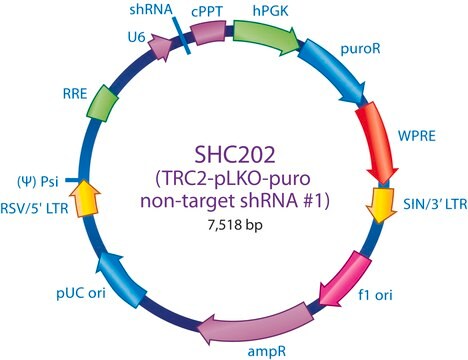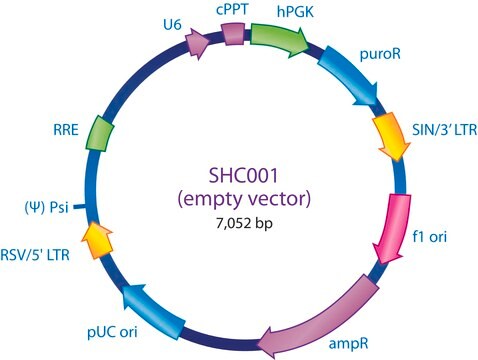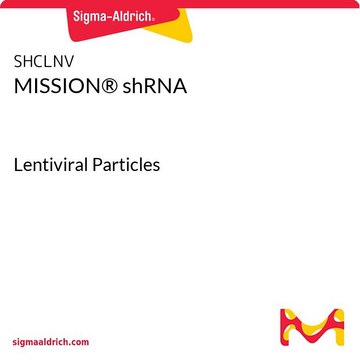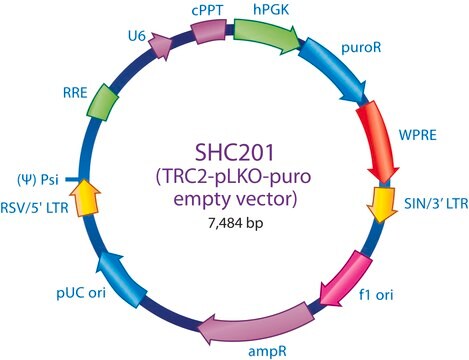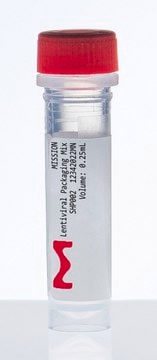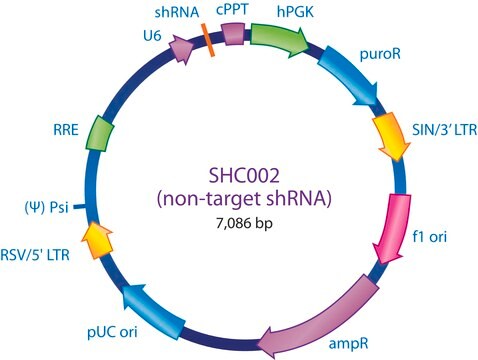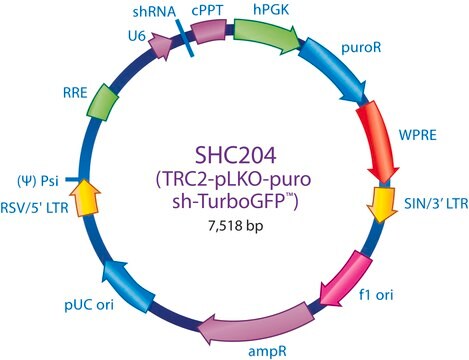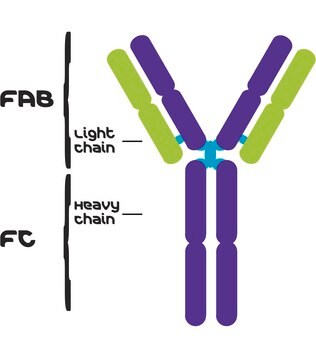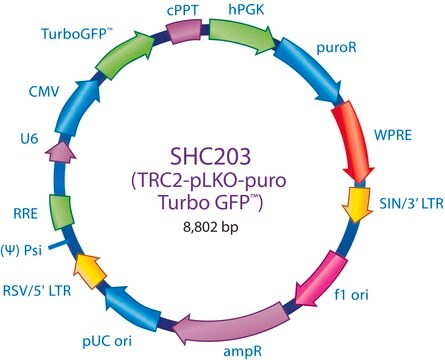SHC201
MISSION® TRC2 pLKO.5-puro Empty Vector Control Plasmid DNA
Contains no shRNA insert
Sinônimo(s):
MISSION® Control Vectors
Faça loginpara ver os preços organizacionais e de contrato
About This Item
Produtos recomendados
Nível de qualidade
linha de produto
MISSION®
concentração
500 ng/μL in TE buffer; DNA (10μg of plasmid DNA)
Condições de expedição
dry ice
temperatura de armazenamento
−20°C
Procurando produtos similares? Visita Guia de comparação de produtos
Categorias relacionadas
Descrição geral
The MISSION TRC2 Control Vector pLKO-puro is a lentivirus plasmid vector. This vector is in the TRC2 pLKO-puro plasmid backbone, which contains the WPRE. The vector does not contain an shRNA insert and is useful as a negative control in experiments using the TRC2 MISSION shRNA library clones. This allows one to examine the effect of transfection on gene expression and interpret the knockdown effect seen with shRNA clones.
Ampicillin and puromycin antibiotic resistance genes provide selection in bacterial or mammalian cells respectively. In addition, self-inactivating replication incompetent viral particles can be produced in packaging cells (HEK293T) by co-transfection with compatible packaging plasmids (SHP001). The TRC2 pLKO-puro Control Vector is provided as 10 μg of plasmid DNA in Tris-EDTA (TE) buffer at a concentration of 500 ng/μl.
Ampicillin and puromycin antibiotic resistance genes provide selection in bacterial or mammalian cells respectively. In addition, self-inactivating replication incompetent viral particles can be produced in packaging cells (HEK293T) by co-transfection with compatible packaging plasmids (SHP001). The TRC2 pLKO-puro Control Vector is provided as 10 μg of plasmid DNA in Tris-EDTA (TE) buffer at a concentration of 500 ng/μl.
Aplicação
MISSION® TRC2 pLKO.5-puro Empty Vector Control Plasmid DNA has been used in:
- CRISPR library generation
- Viral constructs
- Plasmid construction
- CRISPR/Cas9-mediated knockouts.
Small interfering RNAs (siRNAs) expressed from short hairpin RNAs (shRNAs) are a powerful way to mediate gene specific RNA interference (RNAi) in mammalian cells. The MISSION product line is based on a viral vector-based RNAi library against annotated mouse and human genes. shRNAs that generate siRNAs intracellularly are expressed from amphotropic lentivirus viral particles, allowing screening in a wide range of mammalian cell lines. In these cell lines, MISSION shRNA clones permit rapid, cost efficient loss-of-function and genetic interaction screens.
To see more application data, protocols, vector maps visit sigma.com/shrna.
Informações legais
Use of this product is subject to one or more license agreements. For details, please see http://sigmaaldrich.com/missionlicense.
MISSION is a registered trademark of Merck KGaA, Darmstadt, Germany
recomendado
Nº do produto
Descrição
Preços
Código de classe de armazenamento
12 - Non Combustible Liquids
Classe de risco de água (WGK)
WGK 3
Ponto de fulgor (°F)
Not applicable
Ponto de fulgor (°C)
Not applicable
Escolha uma das versões mais recentes:
Certificados de análise (COA)
Lot/Batch Number
It looks like we've run into a problem, but you can still download Certificates of Analysis from our Documentos section.
Se precisar de ajuda, entre em contato Atendimento ao cliente
Já possui este produto?
Encontre a documentação dos produtos que você adquiriu recentemente na biblioteca de documentos.
Os clientes também visualizaram
Functional screening implicates miR-371-3p and peroxiredoxin 6 in reversible tolerance to cancer drugs.
Sahu N, et al.
Nature Communications, 7, 12351-12351 (2016)
A CRISPR screen identifies MAPK7 as a target for combination with MEK inhibition in KRAS mutant NSCLC.
Dompe N, et al.
PLoS ONE, 13(6), e0199264-e0199264 (2018)
Silencing of retrotransposons by SETDB1 inhibits the interferon response in acute myeloid leukemia.
Cuellar TL, et al.
The Journal of Cell Biology (2017)
Janet Lau et al.
Nature communications, 8, 14572-14572 (2017-02-22)
Expression of PD-L1, the ligand for T-cell inhibitory receptor PD-1, is one key immunosuppressive mechanism by which cancer avoids eradication by the immune system. Therapeutic use of blocking antibodies to PD-L1 or its receptor PD-1 has produced unparalleled, durable clinical
Dakota L Jones et al.
The Journal of cell biology, 220(5) (2021-02-25)
Matrix stiffness is a central regulator of fibroblast function. However, the transcriptional mechanisms linking matrix stiffness to changes in fibroblast phenotype are incompletely understood. Here, we evaluated the effect of matrix stiffness on genome-wide chromatin accessibility in freshly isolated lung
Nossa equipe de cientistas tem experiência em todas as áreas de pesquisa, incluindo Life Sciences, ciência de materiais, síntese química, cromatografia, química analítica e muitas outras.
Entre em contato com a assistência técnica